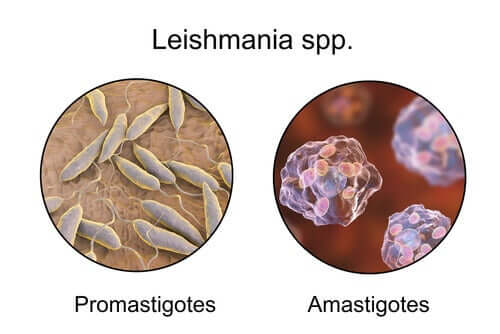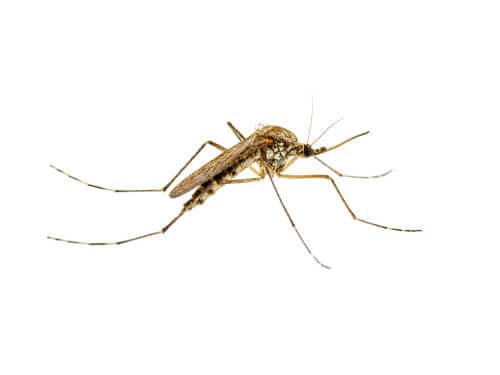Leishmaniasis in Cats: Causes and Treatment

Leishmaniasis in cats is a disease caused by the parasite Leishmania infantum. This parasitic illness can affect a variety of vertebrate species and spreads via invertebrate carriers–typically sand flies.
What is leishmaniasis?
Leishmaniasis refers to a set of symptoms produced by different species of the Leishmania genus. The illness may appear in different forms:
- Cutaneous leishmaniasis (localized or diffuse).
- Mucocutaneous leishmaniasis.
- Visceral leishmaniasis.
According to the World Health Organization (WHO), the parasites that cause leishmaniasis exist in Mexico, Central and South America, Europe, Africa, and Asia. What’s more, these parasites are endemic in tropical and subtropical regions.
Causes of leishmaniasis
The parasite responsible for feline leishmaniasis (FL) is Leishmania infantum. This protozoa parasite requires a vector in order to spread to other vertebrate species.
The vector usually belongs to the Phelotobomus genus in the case of Europe, Asia, and Africa. In the Americas, the Lutzomyia genus is the most common vector.
Experts believe that sand flies are the main transmitters of this feline illness. Infection occurs when these insects feed on cats. In the same way, non-carrying sand flies become infected when they bite infected cats. Therefore, infected cats can act as an additional food source for L. infantum.
The biological cycle of this protozoa is complex. It involves a series of morphological changes depending on their host. The flies infect their vertebrate host with the protozoa promastigote form.
After infection, the macrophages of the host engulf the promastigotes. In this manner, within the macrophages, the promastigotes transform into amastigotes.

Factors that affect the occurrence of Leishmaniasis
Different factors are capable of having an impact on the ramifications of this protozoa parasite. Among those factors are the following:
- The number of infected vectors.
- Sandfly density (the flies that act as vectors of transmission).
- Host density.
- The appearance of new reservoirs in a geographical area.
- Meteorological factors. Specifically, temperature and humidity.
Symptoms of leishmaniasis in cats
The most frequent signs of this illness include skin lesions or discrete mucocutaneous lesions on the head or distal extremities. It can also cause swelling of the lymph nodes.
Less frequently, leishmaniasis in cats can cause ocular lesions, oral lesions, or weight loss. And, occasionally, symptoms can include jaundice, fever, vomiting, diarrhea, dehydration, and other symptoms.
In any case, if a veterinarian suspects a cat may have leishmaniasis, they should ask for a complete blood count, a biochemical profile, and a urine analysis. What’s more, to confirm the presence of the parasite, a laboratory culture will be necessary.
The treatment of leishmaniasis in cats
To date, no controlled studies regarding the treatment of LF have been found. Normally, professionals prescribe the same medication as they do for dogs.
The most common medication is allopurinol. However, veterinarians may also prescribe a combination of allopurinol and meglumine antimoniate. Studies have shown the effectiveness of this medication. However, a vet will decide the best course of action.
During the period of treatment administration, it’s important to monitor cats closely to rule out any adverse reactions. In the case of any undesirable side effects, a veterinarian will decide how to respond.
It’s best to have confirmation of the presence of parasites before prescribing any sort of treatment for the cat.

Tips for preventing leishmaniasis in cats
In order to prevent feline leishmaniasis, veterinarians and specialized personnel often offer a series of suggestions.
- Leishmaniasis is more common in immunosuppressed cats, whether they suffer from feline immunodeficiency (FIV), feline leukemia (FeLV) or other illnesses. Therefore, cats in this condition require extra precaution.
- Cat owners can use topical insecticides, although there is no proof of their effectiveness.
Conclusions
Feline leishmaniasis is occasional, as the parasite is less common in cats than in dogs. This doesn’t mean that cats are more resistant to L. infantum, but, rather, it may be a case of infra diagnosis. Specialists may confuse the illness with other diseases, and veterinarians may be less aware of leishmaniasis in cats than in dogs.
Leishmaniasis can also occur in human beings. Around 20 different species of Leishmania are responsible for infection when it comes to humans.
Leishmaniasis in cats is a disease caused by the parasite Leishmania infantum. This parasitic illness can affect a variety of vertebrate species and spreads via invertebrate carriers–typically sand flies.
What is leishmaniasis?
Leishmaniasis refers to a set of symptoms produced by different species of the Leishmania genus. The illness may appear in different forms:
- Cutaneous leishmaniasis (localized or diffuse).
- Mucocutaneous leishmaniasis.
- Visceral leishmaniasis.
According to the World Health Organization (WHO), the parasites that cause leishmaniasis exist in Mexico, Central and South America, Europe, Africa, and Asia. What’s more, these parasites are endemic in tropical and subtropical regions.
Causes of leishmaniasis
The parasite responsible for feline leishmaniasis (FL) is Leishmania infantum. This protozoa parasite requires a vector in order to spread to other vertebrate species.
The vector usually belongs to the Phelotobomus genus in the case of Europe, Asia, and Africa. In the Americas, the Lutzomyia genus is the most common vector.
Experts believe that sand flies are the main transmitters of this feline illness. Infection occurs when these insects feed on cats. In the same way, non-carrying sand flies become infected when they bite infected cats. Therefore, infected cats can act as an additional food source for L. infantum.
The biological cycle of this protozoa is complex. It involves a series of morphological changes depending on their host. The flies infect their vertebrate host with the protozoa promastigote form.
After infection, the macrophages of the host engulf the promastigotes. In this manner, within the macrophages, the promastigotes transform into amastigotes.

Factors that affect the occurrence of Leishmaniasis
Different factors are capable of having an impact on the ramifications of this protozoa parasite. Among those factors are the following:
- The number of infected vectors.
- Sandfly density (the flies that act as vectors of transmission).
- Host density.
- The appearance of new reservoirs in a geographical area.
- Meteorological factors. Specifically, temperature and humidity.
Symptoms of leishmaniasis in cats
The most frequent signs of this illness include skin lesions or discrete mucocutaneous lesions on the head or distal extremities. It can also cause swelling of the lymph nodes.
Less frequently, leishmaniasis in cats can cause ocular lesions, oral lesions, or weight loss. And, occasionally, symptoms can include jaundice, fever, vomiting, diarrhea, dehydration, and other symptoms.
In any case, if a veterinarian suspects a cat may have leishmaniasis, they should ask for a complete blood count, a biochemical profile, and a urine analysis. What’s more, to confirm the presence of the parasite, a laboratory culture will be necessary.
The treatment of leishmaniasis in cats
To date, no controlled studies regarding the treatment of LF have been found. Normally, professionals prescribe the same medication as they do for dogs.
The most common medication is allopurinol. However, veterinarians may also prescribe a combination of allopurinol and meglumine antimoniate. Studies have shown the effectiveness of this medication. However, a vet will decide the best course of action.
During the period of treatment administration, it’s important to monitor cats closely to rule out any adverse reactions. In the case of any undesirable side effects, a veterinarian will decide how to respond.
It’s best to have confirmation of the presence of parasites before prescribing any sort of treatment for the cat.

Tips for preventing leishmaniasis in cats
In order to prevent feline leishmaniasis, veterinarians and specialized personnel often offer a series of suggestions.
- Leishmaniasis is more common in immunosuppressed cats, whether they suffer from feline immunodeficiency (FIV), feline leukemia (FeLV) or other illnesses. Therefore, cats in this condition require extra precaution.
- Cat owners can use topical insecticides, although there is no proof of their effectiveness.
Conclusions
Feline leishmaniasis is occasional, as the parasite is less common in cats than in dogs. This doesn’t mean that cats are more resistant to L. infantum, but, rather, it may be a case of infra diagnosis. Specialists may confuse the illness with other diseases, and veterinarians may be less aware of leishmaniasis in cats than in dogs.
Leishmaniasis can also occur in human beings. Around 20 different species of Leishmania are responsible for infection when it comes to humans.
All cited sources were thoroughly reviewed by our team to ensure their quality, reliability, currency, and validity. The bibliography of this article was considered reliable and of academic or scientific accuracy.
-
Leishmaniasis – Enfermedades infecciosas [Internet]. Manual MSD versión para profesionales. [citado 9 de agosto de 2019]. Disponible en: https://www.msdmanuals.com/es/professional/enfermedades-infecciosas/protozoos-extraintestinales/leishmaniasis
-
Portal Veterinaria. Leishmaniosis felina [Internet]. [citado 9 de agosto de 2019]. Disponible en: https://www.portalveterinaria.com//articoli/articulos/26064/leishmaniosis-felina.html
-
Suárez Rodríguez B, Isidoro Fernández B, Santos Sanz S, Sierra Moros MJ, Molina Moreno R, Astray Mochales J, et al. Situación epidemiológica y de los factores de riesgo de transmisión de Leishmania infantum en España. Revista Española de Salud Pública. diciembre de 2012;86(6):555-64. [Internet]. Disponible en: http://scielo.isciii.es/scielo.php?script=sci_arttext&pid=S1135-57272012000600002
-
LeishVet. LEISHMANIOSIS CANINA Y FELINA [Internet]. 2018. Disponible en: http://www.leishvet.org/wp-content/uploads/2018/09/ES-Guidelines.pdf
-
Montserrat Gállego y Cristina Riera. LAS LEISHMANIOSIS HUMANAS: LEISHMANIOSIS AUTÓCTONA POR Leishmania infantum. Control Calidad SEIMC Universitat de Barcelona [Internet]. Disponible en: https://www.seimc.org/contenidos/ccs/revisionestematicas/parasitologia/leish.pdf
This text is provided for informational purposes only and does not replace consultation with a professional. If in doubt, consult your specialist.








